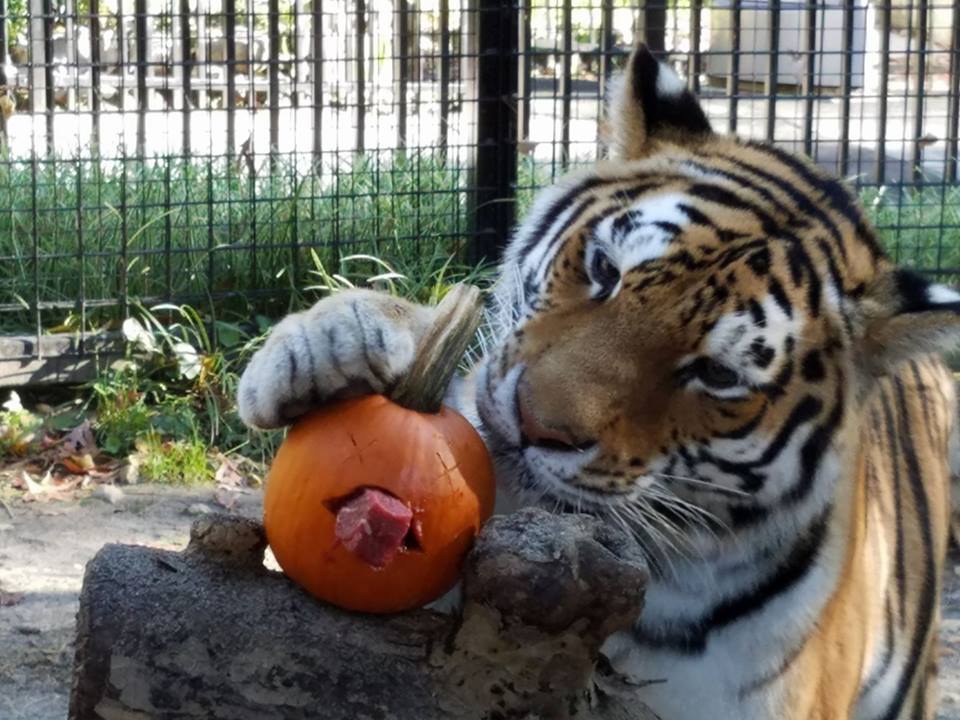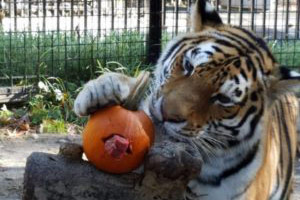
The start of the New Year came with a new adventure for Zhanna, our eight year old female Amur tiger (Panthera tigris altaica). In late 2016, the Brandywine Zoo received a recommendation to transfer Zhanna to the Bronx Zoo in New York City. The Bronx Zoo is a part of the Wildlife Conservation Society (WCS) a conservation organization that manages five accredited zoos and aquariums in the New York area, as well as develops and supports significant conservation projects that directly benefit native species and local people in countries all over the world.
When we received the recommendation to transfer Zhanna, we embraced this opportunity. The Bronx Zoo has over 200 acres and has been at the forefront of animal health and husbandry for decades. Their exhibits are spacious and dynamic for animals, as well as engaging for visitors. Zhanna will now have access to multiple climate controlled holding dens and several outdoor yards on a rotational basis with the other tigers housed in the Wild Asia exhibit. This rotational system provides varying amounts of enrichment as she will be exposed to different portions of the facility every day while seeing, smelling and listening to the other animals in the building. She also has access to five full time veterinarians and a complete modern animal health center equipped to handle emergencies and delicate medical procedures. The carnivore staff at the Bronx collectively has decades of experience with tiger care and husbandry, as well as training and enrichment.
On moving day, her three trainers treated the morning routine like any other. In addition to her normal training sessions, they had been practicing an injection behavior for weeks leading up to the transfer date. Zhanna needed to be lightly sedated in order to complete a brief physical exam prior to shipment. She would then be lifted (while asleep) by hand and placed in the transport crate. Due to the strong relationship that Zhanna had with her trainers (and some goat’s milk as a reinforcer!) the trainers were able to ask Zhanna to ‘lean left’ and ‘hold’ at the mesh, while she calmly allowed them to give her the sedative injection. We had three veterinarians on site that day to assist with this procedure and it went extremely well. After Zhanna was safely secured and fully recovered from the sedative in the transport crate, she began the two and a half hour journey north to New York City. She was transported in a large trailer by a company that specializes in safe animal transport.
All three of Zhanna’s trainers, in addition to the Zoo’s Assistant Curator, were able to accompany her to the Bronx Zoo and aid in her transition. Larger facilities move animals in and out often based on SSP recommendations, but this is a relatively rare occurrence for us. We wanted to provide as much staff as possible with this learning experience. The Bronx Zoo staff was extremely welcoming to Zhanna and our keepers. They provided numerous opportunities for the keepers to converse and share information about Zhanna’s history, personality, training cues and favorite enrichment items. We know she is in excellent hands.
Since our facility is not designed to accommodate multiple tigers with offspring, this transfer created a chance for Zhanna to contribute to the critically endangered population of Amur tigers by being at a zoo that is set up to house breeding tigers and their cubs. She may one day be placed in a breeding situation. That decision will be made based on a number of factors including compatibility of individuals and reproductive success of other recommended pairs. Of the nine subspecies of tigers worldwide, three have gone extinct in the past 100 years. The Amur tiger subspecies in particular is estimated to have a wild population of less than five hundred individuals. Responsible management of the captive population is imperative to preventing extinction.
Both the Bronx Zoo and the Brandywine Zoo are accredited by the Association of Zoos and Aquariums (AZA). AZA accredited facilities are on a mission to adhere to high operating standards which make them leaders in animal welfare, public engagement, and the conservation of species. A part of this mission involves animal transfers between zoos and aquariums in order meet the population management goals of particular species. Many of the animals you see when visiting an AZA accredited zoo are part of the Species Survival Plan or SSP. Simply explained, zoos will only breed animals when there is appropriate physical space available to house offspring and when they are directed to do so by the Studbook Keeper for that particular species.
The Studbook Keeper makes recommendations for breeding based on the genetics of the individual animals to ensure a healthy population, as well as the probability of maintaining that healthy population for the future. This is a daunting task which requires training on specialized computer programs, statistics, AZA codes of ethics and the publications of breeding and transfer plans. These Studbook Keeper positions are purely voluntary and in addition to their regular full time jobs at a zoo or aquarium (usually curators, registrars, directors and zookeepers). Our staff and visitors will truly miss Zhanna at the Brandywine Zoo. However, we see this as a tremendous opportunity for Zhanna and to make needed improvements that will help us complete our overall mission of fostering a connection between people, wild animals and wild habitats. Stay tuned for exciting updates as we plan for our future!

